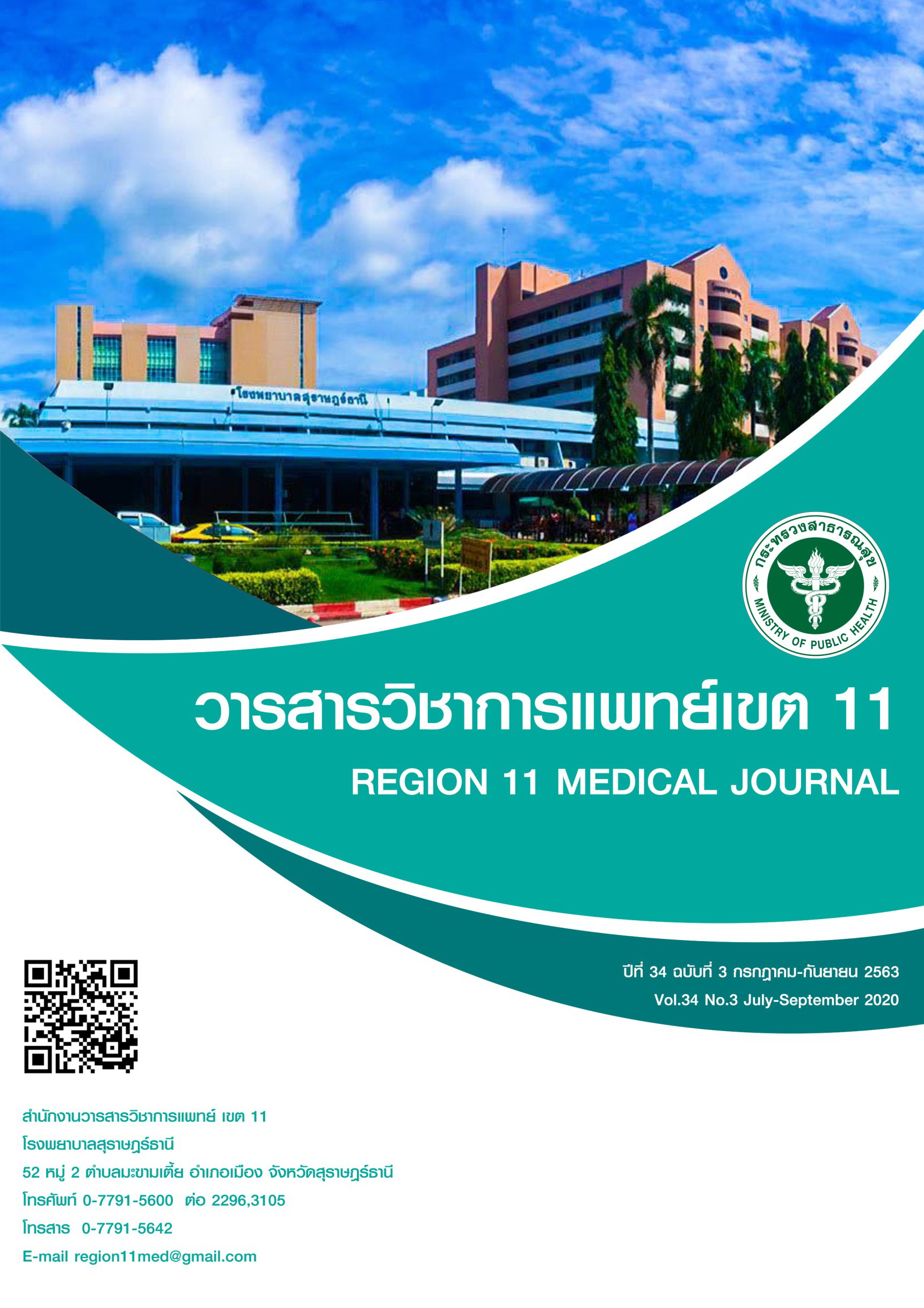Development of the Patient Care Model for Cerebrovascular Disease in Phetchabun Hospital
DOI:
https://doi.org/10.14456/reg11med.2020.1Keywords:
Cerebrovascular disease, Patient Care ModelAbstract
Objectives: This study was a research and development study aimed to develop the patient care model for cerebrovascular disease patients who were admitted to Phetchabun Hospital, and evaluated the results.
Method: Samples were purposively selected. Participants were cerebrovascular patients and multidisciplinary professions. Research instruments were a flow chat guideline for cerebrovascular patients undergoing antithrombolytic treatment and a care map, the dysphagia screening test, the medical record form, and the satisfaction questionnaire from multidisciplinary professions. Four phases of the study: Analyzing the current care service, developing the new model for cerebrovascular patient care, implementing and evaluating. Statistic using for data were analyzed by frequency, percentage, mathematic mean, standard deviation, Chi Square and Mann Whitney U test.
Results: 1) The patient care model for patients with cerebrovascular disease including: An appropriate service flow chart for patient undergoing antithrombotic treatment, the stroke unit, highly skilled multidisciplinary team and a care map. 2) Clinical results showed significantly decreasing door to needle time and complication such as pneumonia (p = 0.013 and <0.001). Also, the NIHSS scores decreased before discharge, complication of urinary tract infection, pressure sores, ADL scores were increasing significantly before discharge, treatment cost and length of stays had no significant differences between before and after applying the newly developed patient care model. The satisfaction results showed that multidisciplinary professions were highly satisfied with this patient care model.
Conclusion: This newly developed patient care model can be use practically with cardiovascular patients due to practicality, promoting team work between multidisciplinary professions and patient holistic care, engendered a distinct clinical practice guideline and building confidence for practitioner. However, there were some unachieved clinical results in this study such as urinary tract infection and bedsore that need to be further developed.
References
สำนักนโยบายและแผนยุทธศาสตร์ กระทรวงสาธารณสุข. ยุทธศาสตร์ตัวชี้วัดและแนวทางการจัดเก็บข้อมูลกระทรวงสาธารณสุขปีงบประมาณ พ.ศ. 2559 [อินเทอร์เน็ต]. 2559 [เข้าถึงเมื่อ 20 เมษายน 2560]. เข้าถึงได้จาก: http://bps2moph.go.th/sites/default/files/kpimoph.
กระทรวงสาธารณสุข. ตัวชี้วัดกระทรวงสาธารณสุข [อินเทอร์เน็ต]. 2561 [เข้าถึงเมื่อ 15 ธันวาคม 2561]. เข้าถึงได้จาก: http://hdcservice.moph.go.th/hdc/reports/repor_kpi.
ดิษนัย ทัศนพูนชัย. โรคหลอดเลือดสมองสาเหตุอัมพฤกษ์อัมพาต [อินเทอร์เน็ต]. 2560 [เข้าถึงเมื่อ 9 กันยายน 2561]. เข้าถึงได้จาก: http://.sikarin.com/content/ Detail/1312stroke.
Powell SK. Case management: A practical guide to success in managed care: Lippincott Williams & Wilkins; 2000.
Borg WR, Gall MD. Research: An Introduction (4th Ed.). New York: Longman; 1983.
พรภัทร ธรรมสโรช, ดิษยา รัตนากร, สามารถ นิธินันทน์, นิจศรี ชาญณรงค์, อรอุมา ชุติเนตร, เจษฎา เขียนดวงจันทร์ และคณะ. ศูนย์โรคหลอดเลือดสมองมาตรฐาน. Thai Stroke Society. 2015;14:75-85.
Stroke unit Trialists’ Collaboration. Organised inpatient (stroke unit) care for stroke. Cochrane Database of Systematic Reviews [Internet]. 2017 [cited 2018 September 9]. Available from: https://www.bmj.com/content/314/7088/1151.short.
ตุลาพร อินทนิเวศน์. ศึกษา กระบวนการการจัดการดูแลผู้ป่วยโรคหลอดเลือดสมองระยะเฉียบพลัน (Stroke fast track) ที่เข้ารับการรักษาในโรงพยาบาลลำพูน. วารสารสาธารณสุขล้านนา. 2017;13(2):35-47.
เรณู มูลแก้ว. ประสิทธิผลของการใช้แนวปฏิบัติทางคลินิกสำหรับการจัดการอาการกลืนลำบากในผู้ป่วยโรคหลอดเลือดสมอง โรงพยาบาลเทพปัญญา จังหวัดเชียงใหม่ [วิทยานิพนธ์ปริญญาพยาบาลศาสตรมหาบัณฑิต]. เชียงใหม่: มหาวิทยาลัยเชียงใหม่; 2557.
วันวิสา คำสัตย์. ผลของกิจกรรมการพยาบาลโดยการสอนแนะต่อการกลืนของผู้ป่วยโรคหลอดเลือดสมองชนิดขาดเลือดที่มีภาวะกลืนลำบาก [วิทยานิพนธ์ปริญญาพยาบาลศาสตรมหาบัณฑิต]. กรุงเทพฯ: จุฬาลงกรณ์มหาวิทยาลัย; 2558.
อุไร คำมาก, ศิริอร สินธุ.ระยะเวลาการให้ยาละลายลิ่มเลือดต่อการฟื้นตัวด้านระบบประสาทของผู้ป่วยโรคหลอดเลือดสมองตีบหรืออุดตันระยะเฉียบพลัน โรงพยาบาลธรรมศาสตร์เฉลิมพระเกียรติ. วารสารพยาบาลทหารบก. 2558;16:106-13.
อรุณรัตน์ อินทสุวรรณ. การพัฒนารูปแบบการดูแลผู้ป่วยโรคหลอดเลือดสมองอุดตัน โรงพยาบาลระนอง. วารสารวิชาการแพทย์ เขต 11. 2559;30:335-43.
ธารารัตน์ ส่งสิทธิกุล, อรวรรณ อนามัย. การพัฒนาระบบบริการพยาบาลผู้ป่วยโรคหลอดเลือดสมองตีบอุดตันที่รักษาด้วยยาละลายลิ่มเลือด โรงพยาบาลราชบุรี. วารสารพยาบาลกระทรวงสาธารณสุข. 2016;26:142-53.






